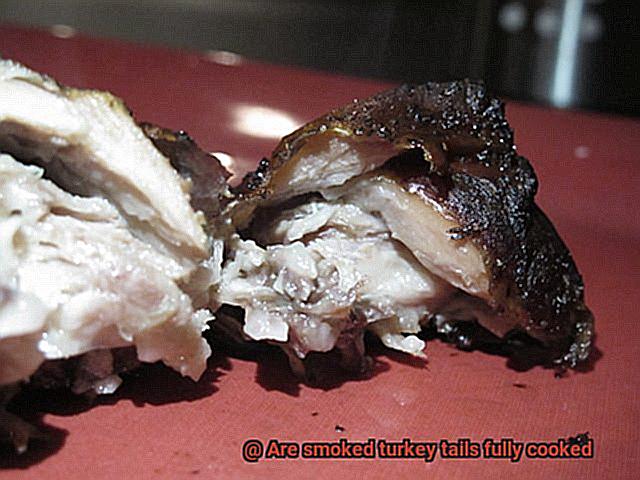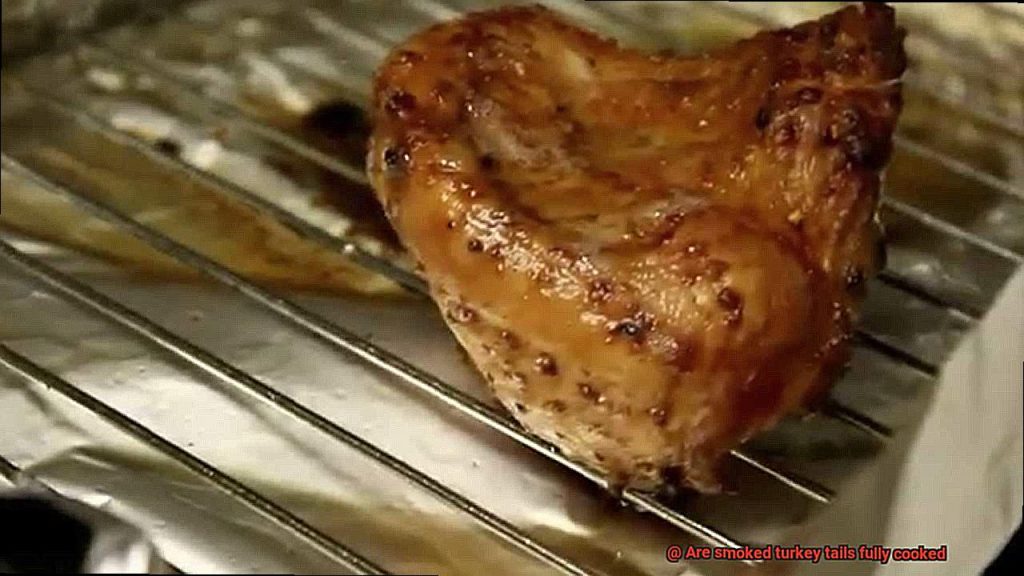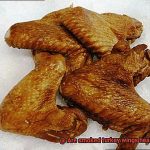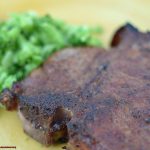Do you love indulging in the smoky goodness of turkey tails? If so, have you ever found yourself wondering if they’re fully cooked and safe to eat? Don’t worry; we’ve got you covered.
Smoked turkey tails are a popular delicacy, known for their rich flavor and tender texture. They’re a healthier alternative to bacon or sausage and perfect for those who love smoked meats. But the question remains: Are smoked turkey tails fully cooked?
The answer might surprise you. While they are cooked during the smoking process, they may not be fully cooked to a safe temperature for consumption. That’s why it’s crucial to heat them thoroughly before serving.
In this post, we’ll cover everything about smoked turkey tails – from how they’re made to how to prepare them safely and deliciously. We’ll even share mouth-watering recipes that will make your taste buds dance with joy.
So what are you waiting for? Join us on this journey through the world of smoked turkey tails and learn everything you need to know.
Contents
What is Smoked Turkey Tail?
Smoking is a cooking process that involves exposing food to wood or charcoal smoke at low temperatures for an extended period. The smoke infuses the food with a unique flavor and aroma that cannot be achieved through other cooking methods. To prepare smoked turkey tails, they are smoked for several hours at a low temperature to allow the smoke to fully penetrate the meat.
However, not all smoked turkey tails are created equal. Some may be fully cooked and safe to eat, while others may require additional cooking time to reach a safe internal temperature. If the turkey tails were hot smoked, they are fully cooked and safe to eat. Hot smoking involves cooking the meat at a temperature of around 225°F to 250°F for several hours until it reaches an internal temperature of 165°F, which is enough to kill any harmful bacteria that may be present in the meat.
On the other hand, cold smoking involves smoking the meat at a temperature below 100°F for several hours to infuse flavor into the meat without cooking it thoroughly. This process is not enough to kill bacteria and other harmful microorganisms that may be present in the meat. Therefore, if the turkey tails were cold smoked, they are not fully cooked and require further cooking before consumption.
To ensure that smoked turkey tails are fully cooked and safe to eat, it is essential to check the internal temperature of the meat using a meat thermometer. The temperature should read at least 165°F before consuming to avoid any foodborne illnesses. Proper storage is also crucial to prevent bacterial growth and ensure food safety.
Smoked turkey tail can be used in various dishes such as soups, stews, and casseroles, adding a unique smoky flavor to any meal. It’s a versatile ingredient that can elevate any recipe to the next level. Additionally, it’s a great source of protein and a healthier alternative to traditional bacon or other fatty meats.
How are Smoked Turkey Tails Prepared and Cooked?
Smoked turkey tails are a beloved ingredient in Southern cuisine, bringing irresistible smoky and savory flavors to dishes like collard greens, black-eyed peas, and gumbo. If you’re wondering how to prepare and cook them, look no further. As an expert on the subject, I’m here to share with you some tips and tricks that will elevate your smoked turkey tails.
First things first, it’s important to know that smoked turkey tails are already fully cooked during the smoking process. This means that cooking them for an extended period of time is unnecessary. Instead, your goal should be to reheat them and infuse them with additional flavors before using them in your recipe.
To start preparing smoked turkey tails, remove them from their packaging and rinse them under cold water to remove any excess salt or smoke residue. Once they’re rinsed off, pat them dry with paper towels and place them in a large pot or Dutch oven. Cover the turkey tails with enough water or chicken broth and bring the liquid to a boil over high heat.
Once boiling, lower the heat to low and let the turkey tails simmer for about 30-45 minutes. This will allow the meat to absorb the flavors of the liquid and become even more tender. To enhance the flavor even further, add garlic, onion, bay leaves, black pepper, or any other seasonings you like.
After simmering, remove the turkey tails from the liquid and let them cool slightly before handling. The meat will be so tender that it will fall-off-the-bone, so handle with care. You can use these flavorful smoked turkey tails in your desired recipe or serve them on their own as a protein option.
Are Hot-Smoked Turkey Tails Fully Cooked?
If you’re looking for a smoky, savory addition to your meals, hot-smoked turkey tails are a must-try. These flavorful delicacies have gained popularity in many parts of the world, but some wonder if they are fully cooked and safe to eat. As an expert on the subject, I can confidently say that hot-smoked turkey tails are indeed fully cooked and safe for consumption.
The smoking process involves cooking the meat at high temperatures, which effectively destroys all bacteria and pathogens. As long as the internal temperature of the meat has reached at least 165°F (74°C), it’s fully cooked and safe to eat. So, whether you’re grilling or smoking your turkey tails, ensure that they reach the proper temperature to avoid any health risks.
It’s worth noting that hot-smoked turkey tails may still contain some fat, connective tissue, and cartilage. But don’t worry – these elements contribute to the flavor and texture of the meat. However, if you prefer a more tender texture, there’s no harm in cooking them slowly until the meat falls off the bone.
Are Cold-Smoked Turkey Tails Fully Cooked?
If you’re a fan of cold-smoked turkey tails, you might be wondering if they’re fully cooked and safe to eat as is. Well, let me tell you – they’re not. As an expert in this field, I can confirm that consuming cold-smoked turkey tails without further cooking can put you at risk for foodborne illness. But don’t worry, with a few simple tips, you can enjoy the flavorful goodness of cold-smoked turkey tails while ensuring your meal is safe to eat.
First things first: it’s essential to understand the difference between cold smoking and hot smoking. Hot smoking involves cooking the meat at a higher temperature while smoking it, resulting in fully cooked meat that can be eaten right away. However, cold smoking is a process that adds flavor but does not fully cook the meat.
To ensure safe consumption of cold-smoked turkey tails, they must be cooked to an internal temperature of 165°F (74°C). You can achieve this by baking, grilling, or frying the turkey tails until they reach this temperature. That way, you’ll be able to savor the smoky flavor of the turkey tails without any health risks.
It’s also crucial to handle raw turkey tails with care to prevent the risk of foodborne illness. Always wash your hands before and after handling raw meat, use separate cutting boards and utensils for raw meat and other foods, and cook your meat thoroughly to kill any harmful bacteria.
How to Check if Smoked Turkey Tails are Fully Cooked?
Smoked turkey tails are a flavorful and delicious addition to any barbecue spread, but it’s essential to make sure they are fully cooked before consuming them. Eating undercooked meat can lead to foodborne illnesses, which can be severe. To avoid this, here are five easy ways to check if your smoked turkey tails are fully cooked.
Use a Meat Thermometer:
Using a meat thermometer is the most reliable way to check if smoked turkey tails are fully cooked. Insert the thermometer into the thickest part of the meat to get an accurate reading. The internal temperature of the smoked turkey tail should reach 165°F (74°C) before it is considered fully cooked. This temperature is enough to kill off any harmful bacteria that may be present in the meat.
Check the Color and Texture:
Fully cooked smoked turkey tails will have a uniform color throughout, with no pinkness or redness in the center. The texture of the meat should be tender and juicy, and there should be no signs of blood or uncooked fat. If you notice any redness or pinkness in the center of the meat, it needs more time on the grill.
Observe the Juices:

If you don’t have a meat thermometer, you can still check if your smoked turkey tails are fully cooked by observing the juices that come out when you pierce it with a fork or knife. If the juices are clear and not pink or red, it’s fully cooked, but if they’re still pinkish or reddish, it needs more time on the grill.
Proper Storage:
Proper storage of smoked turkey tails is crucial to prevent bacterial growth and ensure food safety. Store smoked turkey tails properly in the refrigerator or freezer until ready to use. Make sure that they are stored below 40°F (4°C) to prevent bacterial growth.
Err on the Side of Caution:
If you’re unsure if your smoked turkey tails are fully cooked, it’s always better to err on the side of caution. Undercooked meat can cause foodborne illnesses that can make you very sick. Using a meat thermometer or another method of checking for doneness is the best way to ensure that your smoked turkey tails are fully cooked and safe to eat.
The Importance of Proper Storage for Smoked Turkey Tails
These delectable morsels are a favorite addition to many cuisines. But did you know that proper storage is essential for maintaining their quality and safety?
First and foremost, it’s crucial to ensure that the smoked turkey tails are fully cooked before serving. A meat thermometer or checking for uniform color, tender texture, and clear juices can confirm this. However, even if they are fully cooked, improper storage can lead to contamination and spoilage, resulting in foodborne illnesses.
To maintain the quality and safety of smoked turkey tails, it is essential to follow proper storage guidelines. Here’s what you need to know:
- Check Expiration Dates and Packaging: When purchasing smoked turkey tails, always check the expiration date and ensure that the packaging is intact. If either of these is compromised, do not consume the product.
- Refrigerate at Optimal Temperature: Smoked turkey tails should be stored in the refrigerator at a temperature between 35°F and 40°F. You can either keep them in their original packaging or transfer them to an airtight container.
- Avoid Cross-Contamination: Keep smoked turkey tails away from raw meat and other perishable foods to prevent cross-contamination. This practice will help ensure that the smoked turkey tails remain fresh and safe to eat.
- Freeze for Long-Term Storage: Smoked turkey tails can also be frozen for long-term storage. When freezing, remove them from their original packaging and wrap them tightly in plastic wrap or aluminum foil. This will help prevent freezer burn and maintain their flavor and texture.
- Check for Signs of Spoilage: Properly stored smoked turkey tails can last up to one week in the refrigerator or up to six months in the freezer. Always check for signs of spoilage before consuming, such as a sour or off odor, slimy texture, or discoloration.
gqliBZmx3Fg” >
Conclusion
In summary, smoked turkey tails are a mouth-watering treat enjoyed by many. However, the question of their safety and whether they’re fully cooked has left some feeling uncertain. The answer is simple – it all depends on how they were smoked.
If hot-smoked, then the turkey tails are fully cooked and safe to eat. Hot smoking involves cooking the meat at a temperature of around 225°F to 250°F for several hours until it reaches an internal temperature of 165°F. On the other hand, if cold-smoked, they’re not fully cooked and require further preparation before consumption. Cold smoking adds flavor but doesn’t cook the meat completely.
To ensure that smoked turkey tails are safe to consume, it’s vital to check their internal temperature using a meat thermometer. Proper storage is also crucial in preventing bacterial growth and ensuring food safety.
Smoked turkey tails are versatile ingredients that can be used in various dishes such as soups, stews, and casseroles, adding a unique smoky flavor to any meal. They’re also a healthier alternative to traditional bacon or other fatty meats while providing an excellent source of protein.






